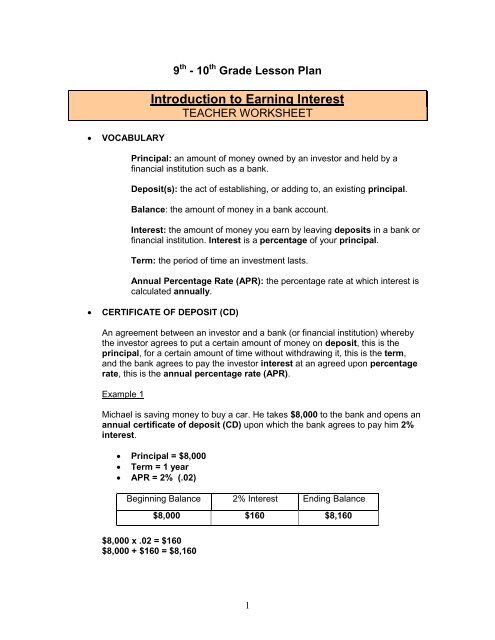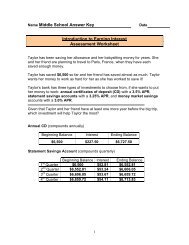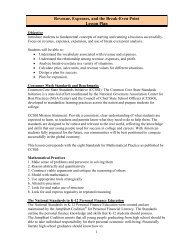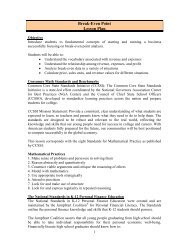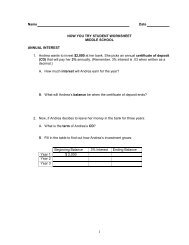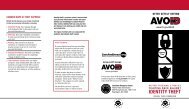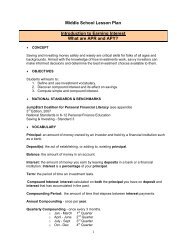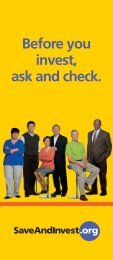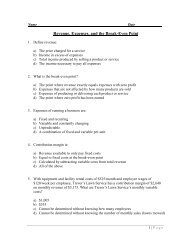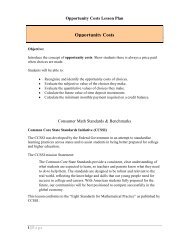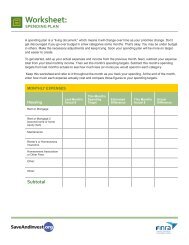9th - 10th Grade - SaveAndInvest.org
9th - 10th Grade - SaveAndInvest.org
9th - 10th Grade - SaveAndInvest.org
Create successful ePaper yourself
Turn your PDF publications into a flip-book with our unique Google optimized e-Paper software.
• VOCABULARY<br />
9 th - 10 th <strong>Grade</strong> Lesson Plan<br />
Introduction to Earning Interest<br />
TEACHER WORKSHEET<br />
Principal: an amount of money owned by an investor and held by a<br />
financial institution such as a bank.<br />
Deposit(s): the act of establishing, or adding to, an existing principal.<br />
Balance: the amount of money in a bank account.<br />
Interest: the amount of money you earn by leaving deposits in a bank or<br />
financial institution. Interest is a percentage of your principal.<br />
Term: the period of time an investment lasts.<br />
Annual Percentage Rate (APR): the percentage rate at which interest is<br />
calculated annually.<br />
• CERTIFICATE OF DEPOSIT (CD)<br />
An agreement between an investor and a bank (or financial institution) whereby<br />
the investor agrees to put a certain amount of money on deposit, this is the<br />
principal, for a certain amount of time without withdrawing it, this is the term,<br />
and the bank agrees to pay the investor interest at an agreed upon percentage<br />
rate, this is the annual percentage rate (APR).<br />
Example 1<br />
Michael is saving money to buy a car. He takes $8,000 to the bank and opens an<br />
annual certificate of deposit (CD) upon which the bank agrees to pay him 2%<br />
interest.<br />
• Principal = $8,000<br />
• Term = 1 year<br />
• APR = 2% (.02)<br />
Beginning Balance 2% Interest Ending Balance<br />
$8,000 $160 $8,160<br />
$8,000 x .02 = $160<br />
$8,000 + $160 = $8,160<br />
1
• VOCABULARY<br />
Example 2<br />
Compound Interest: interest calculated on both the principal you have<br />
on deposit and interest that has accumulated in the past.<br />
Compounding Period: the amount of time that elapses between interest<br />
payments.<br />
Annual Compounding: once per year.<br />
Now, let’s say Michael leaves his money in the bank for four years. The term of<br />
the annual CD is four years, so he will be earning 2% per year for four years.<br />
Since this is an annual CD, interest will be added to the principal at the end of<br />
every year. This is called compounding annually.<br />
Beginning Balance 2% Interest Ending Balance<br />
Year 1 $8,000 $160 $8,160<br />
Year 2 $8,160 $163.20 $8,323.20<br />
Year 3 $8,323.20 $166.46 $8,489.66<br />
Year 4 $8,489.66 $169.79 $8,659.45<br />
• NOW YOU TRY<br />
The students will complete page one of the “Now You Try Student Worksheet.”<br />
• QUARTERLY COMPOUNDING - STATEMENT SAVINGS ACCOUNT<br />
Quarterly Compounding: a type of compounding period in which interest<br />
compounds every three months.<br />
o Jan - March 1 st quarter<br />
o April - June 2 nd quarter<br />
o July - Sept 3 rd quarter<br />
o Oct - Dec 4 th quarter<br />
2
Michael’s bank offers other types of investment accounts in addition to certificates of<br />
deposit (CD). One type of account is called a statement savings account. This type of<br />
account is similar to a certificate of deposit (CD) because it also pays an annual<br />
percentage rate (APR) of interest, but there are some differences too.<br />
A statement savings account doesn’t require Michael to promise to leave the money in<br />
his account for a specific period of time. Michael can go into the bank and withdraw his<br />
money any time he wants. Also, instead of paying Michael his interest only once per year<br />
(annually), the bank will pay him the interest he has earned so far every quarter.<br />
Statement savings accounts often compound quarterly. Michael will receive an<br />
interest payment deposit into his account at the end of every quarter.<br />
When that happens, the interest Michael earned in the previous quarter is added to his<br />
principal and the new balance becomes Michael’s new principal balance for the next<br />
quarter. Now Michael will begin earning interest on his interest! This is called<br />
compound interest.<br />
Example 3<br />
Let’s say Michael takes his $8,000 into the bank and opens a statement savings<br />
account instead of a certificate of deposit. The bank is going to pay him the same 2%<br />
interest on this account that it was offering for the certificate of deposit. Michael’s<br />
beginning principal amount is again $8,000 and his APR is still 2%. However, Michael<br />
gets interest compounded quarterly on this account.<br />
1. First, calculate his annual interest:<br />
$8,000 x .02 = $160<br />
2. Next, calculate what his 1 st quarter interest payment will be:<br />
$160 / 4 = $40<br />
3. Now add Michael’s 1 st quarter interest to his principal balance:<br />
$8,000 + $40 = $8,040<br />
‣ At the end of the 1 st quarter, his principal balance will be $8,040.<br />
4. Now calculate the annual interest he will earn on $8,040.<br />
$8,040 x .02 = $160.80<br />
5. Calculate his 2 nd quarter interest payment:<br />
$160.80 / 4 = $40.20<br />
6. Next, calculate Michael’s new principal balance:<br />
$8,040 + $40.20 = $8,080.20<br />
‣ At the end of the 2 nd quarter his principal balance will be $8,080.20.<br />
3
7. Next, calculate the annual interest he will earn on $8,080.20:<br />
$8,080.20 x .02 = $161.60<br />
8. Calculate his 3 rd quarter interest payment:<br />
$161.60 / 4 = $40.40<br />
9. Add Michael’s 3 rd quarter interest payment to his balance:<br />
$8,080.20 + $40.40 = $8,120.60<br />
‣ At the end of the 3 rd quarter his principal balance will be: $8,120.60<br />
10. Finally, calculate the annual interest with a balance of $8,120.60:<br />
$8,120.60 x .02 = $162.41<br />
11. Calculate his 4 th quarter interest payment:<br />
$162.41 / 4 = $40.60<br />
12. Add his 4 th quarter interest payment to his balance:<br />
$8,120.60 + $40.60 = $8,161.20<br />
‣ At the end of the 4 th quarter his principal balance will be $8,161.20.<br />
After four quarters have passed, Michael has had his money in the statement savings<br />
account for one year. His ending balance at the end of that year is $8,161.20.<br />
Do you remember what his ending balance would have been if he had opened a<br />
certificate of deposit instead? ($8,160)<br />
Let’s compare these two choices. Which type of account would have earned Michael<br />
more interest?<br />
How much more interest would Michael earn by opening the statement savings<br />
account instead of the annual certificate of deposit? ($1.20)<br />
Why? Both accounts were paying the same 2% APR, why were the balances different at<br />
the end of the year?<br />
If 2% of $8,000 is $160, and he earned $161.20 in the statement savings account, then<br />
he must have actually earned more than 2% in the statement savings account.<br />
This is because he earned interest on his interest during the year. His statement<br />
savings account yielded more than 2% for the year.<br />
This extra money he earned, because of compounding interest, is called annual<br />
percentage yield (APY).<br />
4
• VOCABULARY<br />
ANNUAL PERCENTAGE YIELD (APY): the actual rate your money earns<br />
taking compounding into consideration.<br />
To calculate the APY, we divide the amount of interest he earned for the year by his<br />
original principal deposit.<br />
$161.20 / $8,000 = .02015 = 2.015%.<br />
So, the statement savings account, paying an APR of 2% will earn an APY of 2.015%<br />
because of the effect of compound interest.<br />
• NOW YOU TRY<br />
The students will complete page two of the “Now You Try Student Worksheet.”<br />
• COMPOUND INTEREST FORMULA<br />
As you can see, compounding several times per year and holding an investment for<br />
multiple years would make for a lot of manual calculations. Luckily, there is a formula<br />
called the compound interest formula that allows us to calculate the accumulated<br />
balance of an investment across multiple years and multiple compounding periods.<br />
The teacher will introduce the compound interest formula below:<br />
r<br />
A = P( 1+<br />
)<br />
n<br />
nt<br />
Where: A = Accumulated Balance<br />
P = Principal<br />
r = APR expressed as a decimal<br />
n = number of compounding periods/year<br />
t = number of years the investment lasts<br />
Use the same example:<br />
Let’s say Michael takes his $8,000 into the bank and opens a statement savings<br />
account instead of a certificate of deposit. The bank is going to pay him the same 2%<br />
interest on this account that it was offering for the CD. Michael’s beginning principal<br />
amount is again $8,000 and his APR is still 2%. However, Michael gets interest<br />
compounded quarterly on this account.<br />
Principal = $8,000<br />
APR = 2% or .02<br />
n = 4 (quarterly)<br />
t = 1 year<br />
r nt<br />
A = P(1<br />
+ )<br />
n<br />
.02<br />
A = $8,000(1 + )<br />
4<br />
4<br />
A = $8,000(1.005)<br />
A = $8,000(1.02015)<br />
A = $8,161.20<br />
5<br />
4(1)
Compare the interest calculated using the formula with the interest calculated when we<br />
did the calculation “the long way” by hand. Notice the interest amounts match: $161.20.<br />
Annual Percentage Yield (APY) = $161.20 / $8,000 = .02015 = 2.015%<br />
• NOW YOU TRY<br />
The students will complete page three of the “Now You Try Student Worksheet.”<br />
r nt<br />
A = P(1<br />
+ )<br />
n<br />
.03<br />
A = $7,500(1 + )<br />
4<br />
A = $7,500(1.0075)<br />
4(1)<br />
A = $7,500(1.030339)<br />
A = $7,500(1.03034)<br />
A = $7,727.55<br />
4<br />
• MONTHLY COMPOUNDING - MONEY MARKET SAVINGS ACCOUNT<br />
Compounding Period: the amount of time that elapses between interest<br />
payments.<br />
Monthly Compounding: when interest compounds once per month.<br />
Michael’s bank offers another type of investment account called a money market<br />
savings account. This account works just like the statement savings account except the<br />
compounding period is monthly instead of quarterly.<br />
Most money market savings accounts compound monthly. Michael will receive an<br />
interest payment deposit into his account at the end of every month.<br />
When that happens, the interest Michael earned in the previous month is added to his<br />
principal and the new balance becomes Michael’s new principal balance for the next<br />
month. Now Michael will begin earning interest on his interest monthly!<br />
Example 4<br />
This time, Michael takes his $8,000 into the bank and opens a money market savings<br />
account instead of a statement savings account. The bank is going to pay him the<br />
same 2% on this account that it was offering for the statement savings account. Michael’s<br />
beginning principal amount is again $8,000 and his APR is still 2%. However, Michael<br />
gets interest compounded monthly on this account.<br />
6
The 1 st Quarter Interest Calculations<br />
1. First, calculate his annual interest:<br />
$8,000 x .02 = $160<br />
2. Next, calculate what his 1 st month’s interest payment will be:<br />
$160 / 12 = $13.33<br />
3. Now add the 1 st month’s interest to his principal balance:<br />
$13.33 + $8,000 = $8,013.33<br />
‣ At the end of the 1 st month Michael’s principal balance will be $8,013.33.<br />
4. Next, calculate the annual interest he will earn on $8,013.33:<br />
$8,013.33 x .02 = $160.27<br />
5. Calculate his 2 nd month’s interest payment:<br />
$160.27 / 12 = $13.36<br />
6. Now add his 2 nd month’s interest to his principal:<br />
$13.36 + $8,013.33 = $8,026.69<br />
‣ At the end of the 2 nd month his principal balance will be $8,026.69.<br />
7. For the 3 rd month, calculate the annual interest he will earn on $8,026.69:<br />
$8,026.69 x .02 = $160.53<br />
8. Next, calculate his 3 rd month’s interest payment:<br />
$160.53 / 12 = $13.38<br />
9. Add Michael’s 3 rd month’s interest to his principal balance:<br />
$13.38 + 8,026.69 = $8,040.07<br />
‣ At the end of the 3 rd month his principal balance will be $8,040.07.<br />
10. At the end of three months, we have completed the 1 st quarter.<br />
What would Michael’s balance have been at the end of the 1 st quarter if he had a<br />
statement savings account compounding quarterly? ($8,040)<br />
7
Calculations for all 12 months of the year:<br />
Beginning Balance 2% Interest Ending Balance<br />
1 st Month $8,000 $13.33 $8,013.33<br />
2 nd Month $8,013.33 $13.36 $8,026.69<br />
3 rd Month $8,026.69 $13.38 $8,040.07<br />
4 th Month $8,040.07 $13.40 $8,053.47<br />
5 th Month $8,053.47 $13.42 $8,066.89<br />
6 th Month $8,066.89 $13.44 $8,080.33<br />
7 th Month $8,080.33 $13.47 $8,093.80<br />
8 th Month $8,093.80 $13.49 $8,107.29<br />
9 th Month $8,107.29 $13.51 $8,120.80<br />
10 th Month $8,120.80 $13.53 $8,134.33<br />
11 th Month $8,134.33 $13.56 $8,147.89<br />
12 th Month $8,147.89 $13.58 $8,161.47<br />
Note: We rounded the monthly interest calculation up before we added each month’s<br />
interest to the balance at the beginning of the month. There may be as much as a three<br />
cent difference at the end of the year when we calculate the interest using the formula.<br />
This three cent difference still yields the same APY.<br />
Michael’s $8,000 original principal deposit, put into a money market savings account<br />
at 2% APR, compounding monthly would be worth $8,161.47 at the end of one year.<br />
What APY does this account yield? (.02018 or 2.018% APY)<br />
Now, let’s try using the formula:<br />
Principal = $8,000<br />
APR = 2% or .02<br />
n = 12 (monthly)<br />
t = 1 year<br />
r nt<br />
A = P(1<br />
+ )<br />
n<br />
.02 12(1)<br />
A = $8,000(1 + )<br />
12<br />
12<br />
A = $8,000(1.001666)<br />
A = $8,000(1.02018)<br />
A = $8,161.44<br />
$161.44<br />
APY = = .02018 = 2. 018APY<br />
$8,000<br />
• NOW YOU TRY<br />
The students will complete page four of the “Now You Try Student Worksheet.”<br />
8
• COMPARE ANNUAL, QUARTERLY AND MONTHLY COMPOUNDING<br />
Discussion:<br />
1. If the APR is the same on all three investments, which is the best investment?<br />
o<br />
The investment with the greatest number of compounding periods is the<br />
best investment.<br />
2. How do you think a bank might entice you to open CDs or statement savings<br />
accounts instead of always opening money market accounts?<br />
o<br />
A bank might entice a person to open CDs or statement savings accounts<br />
by offering a higher APR on products with less compounding periods.<br />
Assessment/ Evaluation<br />
o<br />
The teacher will assess the students’ knowledge of APR, APY, and<br />
compound interest using the 9 th - 10 th <strong>Grade</strong> Assessment Worksheet.<br />
9


